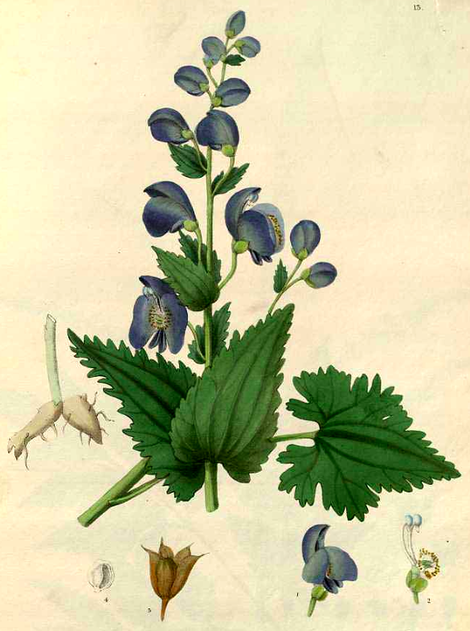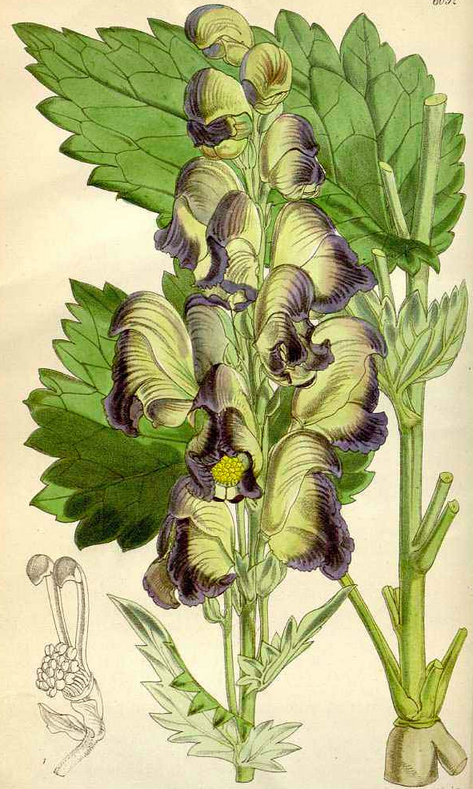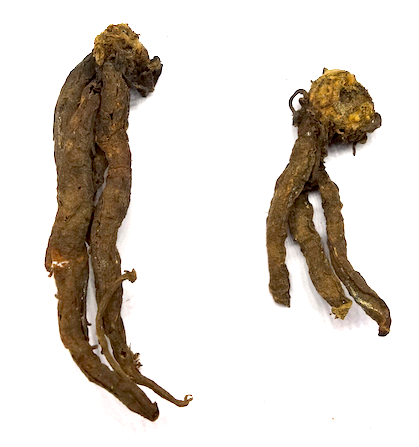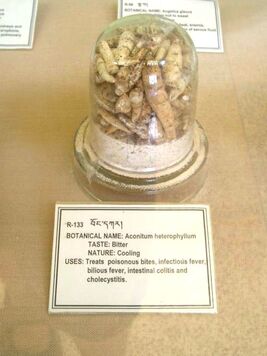Sentry Page Protection
Aconitum heterophyllum, Atis བོང་ང་དཀར་པོ
Ativisha, Atis, Atees (Ayurveda)
Athividyam (Siddha)
Atis, Atees (Unani)
Bong nga dkar po, Bong dkar 'White Aconite' (Tibetan)
Yi Ye Wu Tou (TCM)
Athividyam (Siddha)
Atis, Atees (Unani)
Bong nga dkar po, Bong dkar 'White Aconite' (Tibetan)
Yi Ye Wu Tou (TCM)
Aconitum heterophyllum
Royle, J.F., Illustrations of the botany and other branches of the natural
history of the Himalayan Mountains and of the flora of Cashmere, 1839
Royle, J.F., Illustrations of the botany and other branches of the natural
history of the Himalayan Mountains and of the flora of Cashmere, 1839
Aconitum heterophyllum
Curtis’s Botanical Magazine, 1874
Curtis’s Botanical Magazine, 1874
Aconitum heterophyllum root
(Calcutta Unani College, Adam, 2019)
(Calcutta Unani College, Adam, 2019)
|
Botanical name:
Aconitum heterophyllum Two main varieties of Atis are available on the Indian Market:
Kletter (Tibetan Medicine Plants) lists the following species used as alternate sources:
In various other regions, other species are reportedly used:
|
Sample of A. heterophyllum root at
the Library ofTibetan Works & Archives, Dharamsala, India (Adam, 2006) |
Parts used:
Root
According to some Tibetan texts, the whole plant is used. It is possible the whole plant is used due to its increasing rarity and high cost in some regions.
Temperature & Taste:
Warm, dry. Bitter
Constituents
-Diterpene Alkaloids (0.7%): Atisine (0.4% in root), Atidine, Hetratisine, Heterophylline, Heterophyllidine, Heterophyllisine, Hetisine, Hetidine, Hetisinone, Isoatisine
-Tannin, Fatty acids, carbohydrates, trace minerals
Uses:
1. Clears Heat and Poison:
-Fever, Bilious Fever, Intermittent and Malarial Fevers
-acute Infectious diseases, Epidemic Fever
-acute inflammations.
-acute sore Throat, Cough, Bronchitis (root powder with honey)
-various types of Poison
-Snake and Scorpion bite (Tibet); Rat Bite (Ayurveda)
-childhood diseases: Diarrhea, Cough, Fever, Teething disorders
-important medicine in several of the Tibetan Jewel Pills.
2. Clears Heat and Damp:
-Vomiting, Diarrhea and Dysentery, Gastralgia, especially in Children
-‘putrid Phlegm and Bile’
-Indigestion, Poor Appetite and Obesity
-Ascites and Piles (Unani)
3. Tonic (Rasayana):
-aphrodisiac, Impotence, Sexual Debility
-General Debility, chronic disease, Convalescence.
-Diabetes
-purifies the blood and regulates Vata.
-considered a Brain tonic; loss of Memory.
4. Clears Wind-Damp:
-Rheumatism, Arthritis
-Hypertension
5. Kills Worms and Parasites:
-Giardiasis and Guinea-worms
-root prepared boiled in milk is given to children for Worms
6. Contraceptive
-has been regarded as an Anti-fertility drug.
7. Astringent:
-Bleeding Piles, Amenorrhea and Leukorrhea. (Unani)
Dose:
Powder: 1–3 grams; 125–500mg for children
Decoction: 3–5 grams
Substitute:
1. Cyperus rotundus has been regarded as a substitute (Unani). See an article about it as a substitute here.
2. Chebulic Myrobalan has been suggested as a substitute for Ativisha (Yogaratnakara)
3. Trollius ranunculoides has apparently been used as a substitute.
4. Cinchona (as an anti-periodic) (Waring)
5. Celastrus paniculatus has shown similar effects (see here)
Comment:
Aconites are one of the most poisonous families used in herbal medicines. However, Aconitum heterophyllum is regarded as non-poisonous. Atisine, the primary alkaloid is much less toxic than aconitine and other aconite alkaloids. It is very mildly poisonous, but requires no purification as the other Aconites do, and is regularly used in pediatric diseases in Ayurveda. The poisonous Aconites are pungent and numbing to the taste, whereas A. heterophyllum (and related species) are extremely bitter, with no numbing effect. The confusion around the Aconites still leads so-called reputable sources to claim this aconite to be highly toxic.
Powder: 1–3 grams; 125–500mg for children
Decoction: 3–5 grams
Substitute:
1. Cyperus rotundus has been regarded as a substitute (Unani). See an article about it as a substitute here.
2. Chebulic Myrobalan has been suggested as a substitute for Ativisha (Yogaratnakara)
3. Trollius ranunculoides has apparently been used as a substitute.
4. Cinchona (as an anti-periodic) (Waring)
5. Celastrus paniculatus has shown similar effects (see here)
Comment:
Aconites are one of the most poisonous families used in herbal medicines. However, Aconitum heterophyllum is regarded as non-poisonous. Atisine, the primary alkaloid is much less toxic than aconitine and other aconite alkaloids. It is very mildly poisonous, but requires no purification as the other Aconites do, and is regularly used in pediatric diseases in Ayurveda. The poisonous Aconites are pungent and numbing to the taste, whereas A. heterophyllum (and related species) are extremely bitter, with no numbing effect. The confusion around the Aconites still leads so-called reputable sources to claim this aconite to be highly toxic.
Main Combinations:
Often combined with Cyperus rotundus
1. Diarrhea:
i. Aconitum heterophyllum with Ginger
ii. Aconitum heterophyllum with Nutmeg, Chebula
iii. Aconitum heterophyllum with Cannabis and Calamus
iv. Chronic Diarrhea, Aconitum heterophyllum with Holarrhena antidysenterica
2. Diarrhea with Fever:
i. Aconitum heterophyllum with Ginger, Cyperus rotundus, Holarrhena as a decoction
ii. Aconitum heterophyllum with Ginger, Cyperus rotundus, Tinospora
iii. Fetid Diarrhea:
i. Aconitum heterophyllum with Chebula, Asafetida, Sonchal Salt, Calamus, Rock Salt
ii. Aconitum heterophyllum with Asafetida, Chebula, Three Pungents (Long and Black Pepper, Ginger), Calamus
3. Dysentery, Aconitum heterophyllum with Mesua ferrea, Galls (Siddha)
4. Bowel Pain, Diarrhea, Vomiting, Aconitum heterophyllum with Long Pepper
5. Irritable Bowel, Aconitum heterophyllum with Ginger and Cyperus rotundus (decoction)
6. Abdominal diseases (Udararoga), Aconitum heterophyllum (1 part) with Alangium (3 parts), taken with Rice water (Tandulodaka)
7. Tumors and severe pains in the abdomen:
i. Aconitum heterophyllum with Cyperus rotundus, Cardamon, Sandalwood, Picrorrhiza, Fumitory, Barberry root-bark, Cinnamon, Long and Black Pepper, Ginger (Ayurveda)
ii. Aconitum heterophyllum with Cyperus rotundus, Cissampelos, Holarrhena, Picrorhiza, Turmeric (Ayurveda)
iii. severe abdominal pain, Aconitum heterophyllum with Long Pepper, Asafetida, Ginger, Calamus, Picrorhiza, Chebula (as in Vrisha Dvadasaka or Ayurveda)
8. Indigestion and severe abdominal pain, Aconitum heterophyllum with Asafetida, Ginger, Calamis, Picrorrjhiza, Chebulic Myrobalan
9. Dysuria, Burning and painful urination, Aconitum heterophyllum with Emblic Myrobalan, Ginger, Tribulus, Solanum xanthocarpum (Kantakari)
10. Worms, Aconitum heterophyllum with Chebulis Myrobalan, Costus, Calamus, Embelia (Tibetan)
11. Children diseases including Cough, Fever, Diarrhea, Vomiting:
i. Fever, Cough, Aconitum heterophyllum with Long Pepper
ii. Diarrhea, Aconitum heterophyllum with Calamus
iii. Aconitum heterophyllum with Ginger, Cyperus rotundus, Licorice
iv. Aconitum heterophyllum with Long Pepper, Cyperus rotundus, Pistacia intergerrima (Ayurveda)
12. Tonic for Children, for disorders due to teething, Aconitum heterophyllum with Triphala (3 Myrobalans), Licorice, Chinese Gall, Ginger, Long Pepper, Red Coral, Saffron (Ayurveda)
13. Cough, Fever, Aconitum heterophyllum with Long Pepper and Chinese Gall; sometimes Cyperus rotundus is added (Ayurveda)
14. Rat Bite, powder the root, mix with Honey and take orally. (Ayurveda)
15. Obstinate skin diseases:
i. Aconitum heterophyllum with Holarrhena, Picrorhiza, Cyperus rotundus, Turmeric
ii. Aconitum heterophyllum with Emblic Myrobalan, Picrorhiza, Cyperus rotundus, Sandalwood, Barberry, Calamus, Asparagus, Tinospora, Swertia, Licorice, Fumitory, Cassia fistula, as a medicinal Ghee (Ayurveda)
16. Ulcers & Wounds, Aconitum heterophyllum with Oroxylum (Syonaka), Solanum xanthocarpum (Kantakari) as a paste over the Ulcer.
Major Formulas:
Amomum 19 (Ko la 19) (Tibetan)
Antidotal 18 (Gnyen po bco brgyad) (Tibetan)
Balacaturbhadrika (Ayurveda)
Bright Red Decoction (Dmar chen thang) (Tibetan)
Cloudless Moonbeam (Sprin bral zla 'od) (Tibetan)
Conqueror of Brown Phlegm (Smug po gyul rgyal) (Tibetan)
Cowrie Ash 6 (Mgron thal drug pa) (Tibetan)
Crystal Moon 37 (Zla shel so bdun) (Tibetan)
Emblic 25 (Skyu ru nyer lnga) (Tibetan)
Great Decoction 25 (Thang chen nyer lnga) (Tibetan)
Great Yellow Compound (Sman ser chen mo) (Tibetan)
Influenza Pills (Lo gyon ril bu) (Tibetan)
Joyful 16 Pill (Dg'a ba bchu drug) (Tibetan)
Kutajghan Vati (Holarrhena Tablets)
Minister 9 (Blon po dgu sbyor) (Tibetan)
Notopterygium 29 Pills (Spru nag nyer dgu) (Tibetan)
Pomegranate All Inclusive Pill (Se 'bru kun 'dus) (Tibetan)
Podophyllum 25 ('Ol se nyer lnga) (Tibetan)
Principle 8 (Gtso bo brgyad pa) (Tibetan)
Principle 25 (Gtso bo nyer lnga) (Tibetan)
Pushyanuga Churna (Ayurveda)
Swertia 5 Decoction (Tig ta lnga thang) (Tibetan)
Swertia 8 (Tig ta brgyad pa) (Tibetan)
Swertia 25 (Tig ta nyer lnga) (Tibetan)
Cautions:
1. As this is endangered and very expensive, adulteration is an issue. Be certain that other aconite species have not been substituted. The genuine A. heterophyllum is very bitter without numbing sensation when tasted.
2. Generally well tolerated in recommended doses.
Toxicity:
Overdose may cause dry mouth, nausea, vomiting, diarrhea, tremors, convulsions, abdominal spasms and dehydration.
Overdose can occur at around 5–6 grams.
Main Preparations used:
1. As this is endangered and very expensive, adulteration is an issue. Be certain that other aconite species have not been substituted. The genuine A. heterophyllum is very bitter without numbing sensation when tasted.
2. Generally well tolerated in recommended doses.
Toxicity:
Overdose may cause dry mouth, nausea, vomiting, diarrhea, tremors, convulsions, abdominal spasms and dehydration.
Overdose can occur at around 5–6 grams.
Main Preparations used:
Click the Tabs above for more information on this Medicine
GENERAL / REVIEW
–ACONITUM HETEROPHYLLUM (ATIVISHA) IN AYURVEDA
–Aconitum heterophyllum-An Overview
–Aconitum heterophyllum Wall. ex Royle: A critically endangered medicinal herb with rich potential for use in medicine
–Primary pharmacological and other important findings on the medicinal plant “Aconitum heterophyllum”(aruna)
–The alkaloids of Aconitum heterophyllum Wall.: Isolation and characterization
–A complete review on Ativisha-Aconitum heterophyllum
–AN EXHAUSTIVE REVIEW ON PHARMACOLOGICAL POTENTIAL OF Aconitum heterophyllum
ANTIBACTERIAL
–Norditerpenoid alkaloids from the roots of Aconitum heterophyllum Wall with antibacterial activity
–Antibacterial property of Aconitum heterophyllum root alkaloid
–In vitro antimicrobial activity of aerial parts extracts of Aconitum heterophyllum Wall. ex Royle
ANTI-INFLAMMATORY
–Anti-inflammatory activity of Aconitum heterophyllum on cotton pellet-induced granuloma in rats
ANTIOXIDANT
–Physicochemical standardization and evaluation of in-vitro antioxidant activity of Aconitum heterophyllum Wall
–Antioxidant and anticholinesterase potential of diterpenoid alkaloids from Aconitum heterophyllum
IMMUNOMODULATING
–Immunomodulating agents of plant origin. I: Preliminary screening
ANTICONVULSANT
–Evaluation of Anticonvulsant Activity of Chloroform Root Extract of Aconitum Heterophyllum
ANTICHOLINESTERASE ACTIVITY
–Antioxidant and anticholinesterase potential of diterpenoid alkaloids from Aconitum heterophyllum
NEPHROPROTECTIVE
–Antioxidant and nephroprotective activities of aconitum heterophyllum root in glycerol induced acute renal failure in rats
ANTI-ULCER
–Evaluation of Antiulcer activity of Aconitum heterophyllum on experimental animal
DIARRHEA
–Antisecretory and antimotility activity of Aconitum heterophyllum and its significance in treatment of diarrhea
–The antidiarrheal and C19/C20 diterpenoid alkaloid constituents of high altitude Himalayan Aconitum heterophyllum
–ACONITUM HETEROPHYLLUM (ATIVISHA) IN AYURVEDA
–Aconitum heterophyllum-An Overview
–Aconitum heterophyllum Wall. ex Royle: A critically endangered medicinal herb with rich potential for use in medicine
–Primary pharmacological and other important findings on the medicinal plant “Aconitum heterophyllum”(aruna)
–The alkaloids of Aconitum heterophyllum Wall.: Isolation and characterization
–A complete review on Ativisha-Aconitum heterophyllum
–AN EXHAUSTIVE REVIEW ON PHARMACOLOGICAL POTENTIAL OF Aconitum heterophyllum
ANTIBACTERIAL
–Norditerpenoid alkaloids from the roots of Aconitum heterophyllum Wall with antibacterial activity
–Antibacterial property of Aconitum heterophyllum root alkaloid
–In vitro antimicrobial activity of aerial parts extracts of Aconitum heterophyllum Wall. ex Royle
ANTI-INFLAMMATORY
–Anti-inflammatory activity of Aconitum heterophyllum on cotton pellet-induced granuloma in rats
ANTIOXIDANT
–Physicochemical standardization and evaluation of in-vitro antioxidant activity of Aconitum heterophyllum Wall
–Antioxidant and anticholinesterase potential of diterpenoid alkaloids from Aconitum heterophyllum
IMMUNOMODULATING
–Immunomodulating agents of plant origin. I: Preliminary screening
ANTICONVULSANT
–Evaluation of Anticonvulsant Activity of Chloroform Root Extract of Aconitum Heterophyllum
ANTICHOLINESTERASE ACTIVITY
–Antioxidant and anticholinesterase potential of diterpenoid alkaloids from Aconitum heterophyllum
NEPHROPROTECTIVE
–Antioxidant and nephroprotective activities of aconitum heterophyllum root in glycerol induced acute renal failure in rats
ANTI-ULCER
–Evaluation of Antiulcer activity of Aconitum heterophyllum on experimental animal
DIARRHEA
–Antisecretory and antimotility activity of Aconitum heterophyllum and its significance in treatment of diarrhea
–The antidiarrheal and C19/C20 diterpenoid alkaloid constituents of high altitude Himalayan Aconitum heterophyllum





